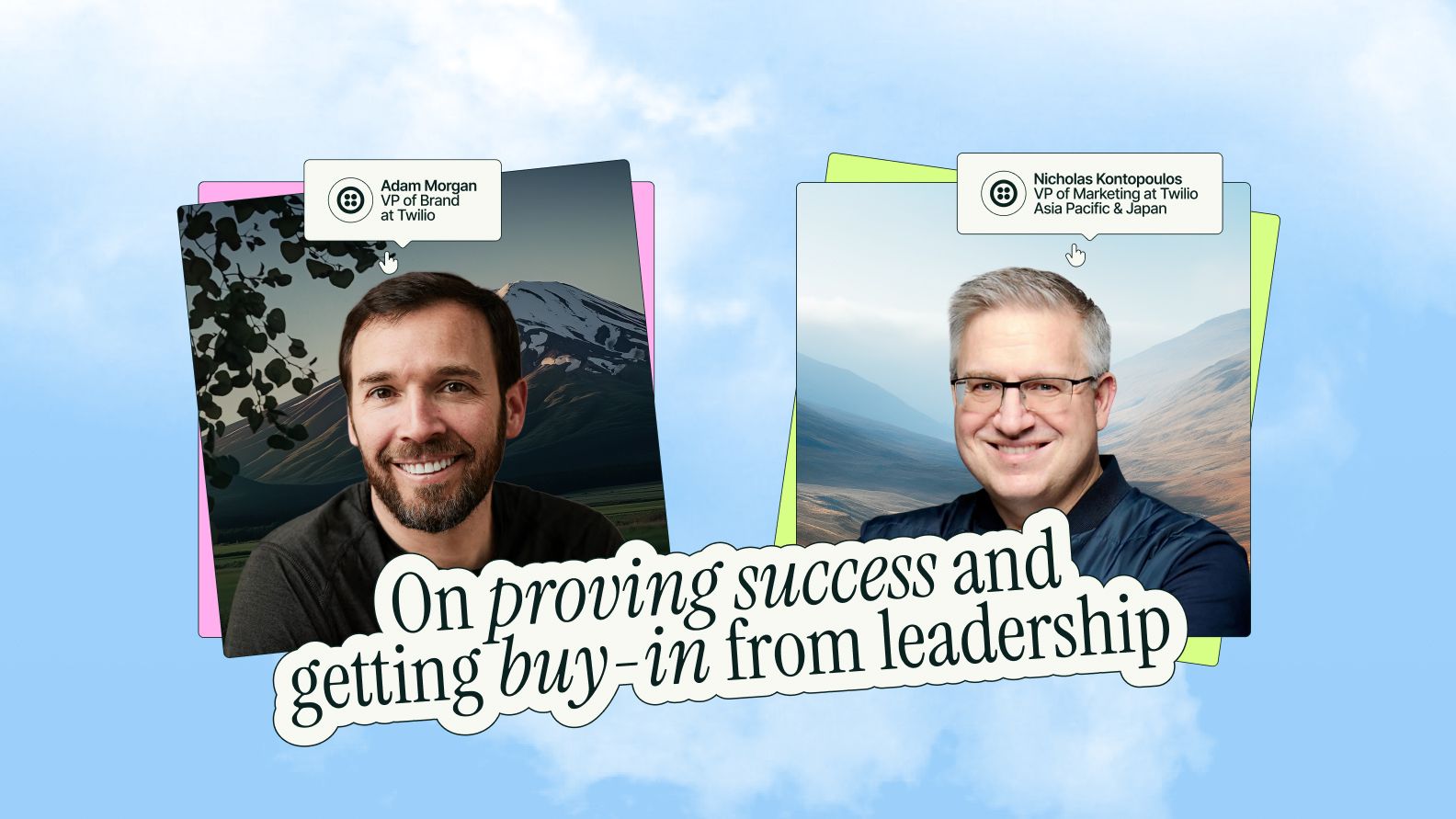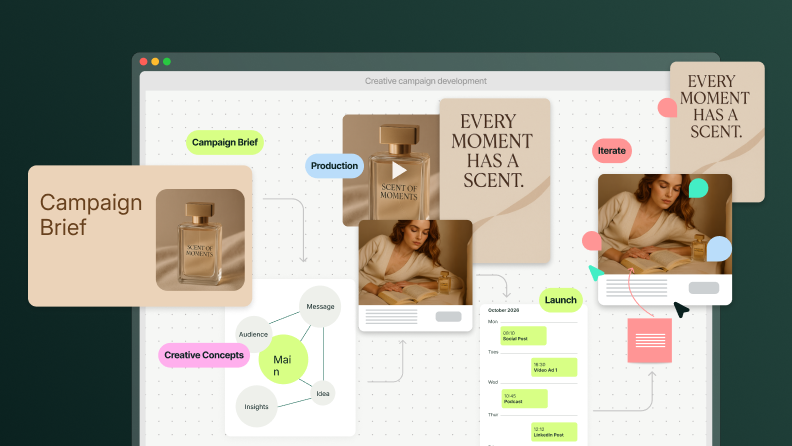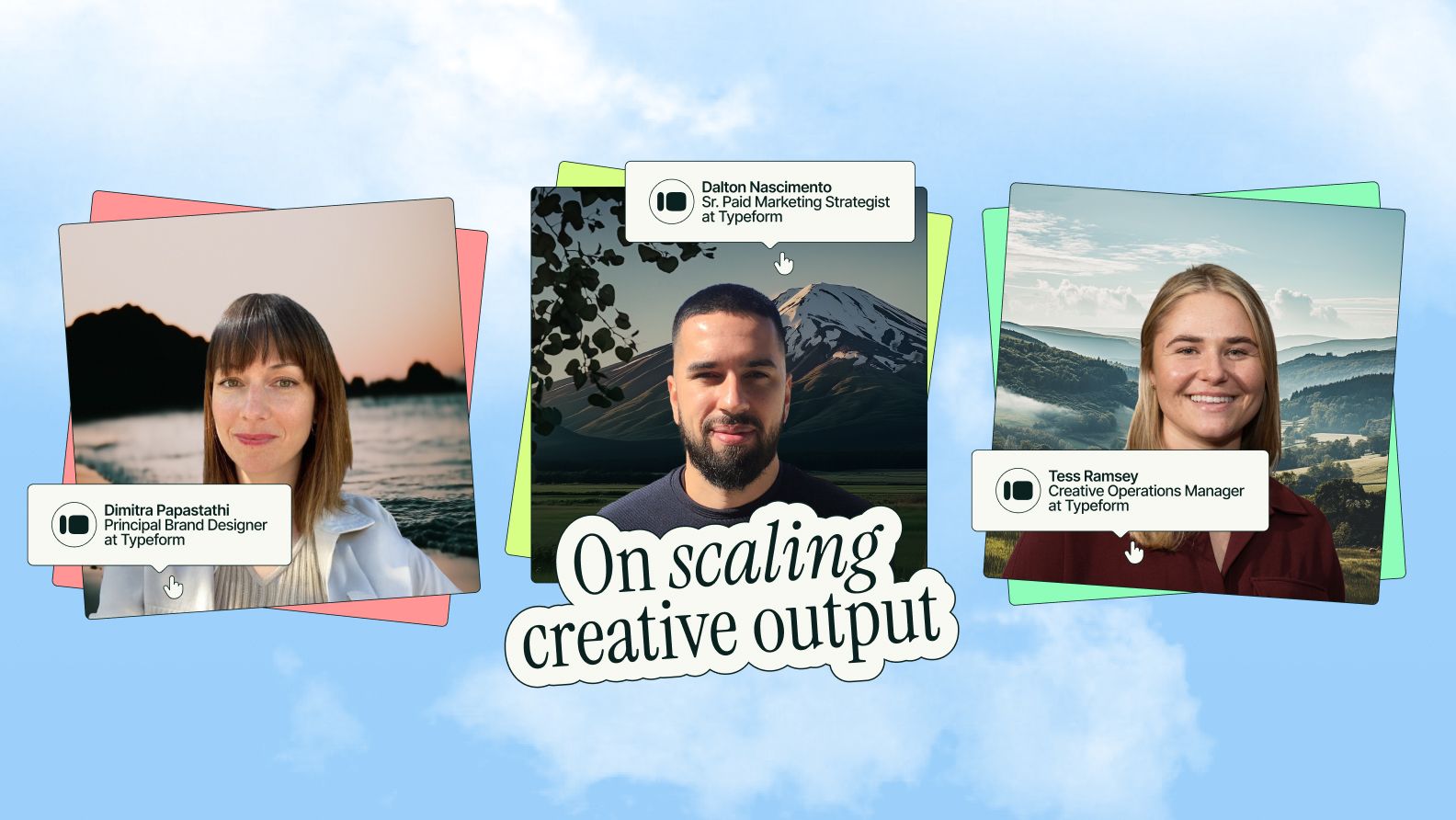Battling Burnout 3: Eliminating (and Preventing) Burnout

This blog post is part three of our Battling Burnout series. Learn how to identify burnout on your team in Part 1: How to Identify Burnout on Your Design Team; learn how to fix burnout in Part 2: How to Fix Burnout on Your Design Team.
When your fridge stops working properly, it’s a big problem. $179 in groceries; that oat milk you can only get at Krogers; the nice bread that needs to be refrigerated. You cancel your 3 p.m. meeting and call the nearest repair service.
The fridge gets fixed right this second, and the rest of the world can wait.
When a design team stops working properly, it can be difficult to replicate oat milk levels of urgency. It’s easier to notice the onset of a lukewarm fridge than it is to notice lukewarm creative, and a design team that’s fizzling out may still technically be “working”. The repair shop’s line remains quiet.
What makes or breaks a design team—and by proxy, a marketing team—is what design and marketing leaders do when they find signs of burnout. Though it can fly under the radar for months or years on end, the resulting loss is far worse than spoiled milk, and demands immediate action from leadership. But fixing burnout isn’t just about avoiding disaster: It’s actively rewarding in ways you wouldn’t expect.
We spoke to some of our clients and partners about how they successfully defeated or circumvented burnout, and the rewards they reaped for doing so.
What you’ll learn
What Happens When Burnout is Fixed?
Your Capacity is Greater (and Your Strategy Bolder)
Fixing Burnout Transforms Design Teams
What Happens When Burnout is Fixed?
It’s easy to think of fixing burnout as a return to normalcy. Your fridge doesn’t suddenly do cartwheels; it goes back to its baseline of keeping food cold.
This is where addressing burnout on your design team differs. Effectiveness and efficiency soar when you cut loose what’s holding them back. Design is no longer “getting by”, or “meeting expectations”, but actively experimenting, engaged in meaningful work, growing and yielding results that cement the brand’s place in its field.
Here, we’ll show you what happens when forward-thinking design teams fight burnout at the source. You’ll learn how high-performing design and marketing leaders circumvent burnout, witness the benefits they’ve wrought, and learn how to replicate them on your own team.
Your Team is Happier
The single best reason to resolve burnout is to eliminate the stress it puts on your design team. It’s the ethical thing to do. They’re all people you presumably trust and value, so their comfort is paramount. When you release the chokehold this stress puts on team members, you put their lives back in their hands.
No, seriously. Remember a couple blogs ago, when we talked about the necessity for passion in creative works? That passion is the only reason your team members pursued design as a career. It’s why they’re not investment bankers, data scientists or anyone else with more zeros on their pay stubs. Creative fulfillment is their guiding light, and it can be personally decimating when it goes out. Conversely, addressing burnout reignites that flame: The lost dog bounds out of the woods, the music swells and the love returns.
Of course, happiness in the abstract has little business value: We’ll talk about what this newfound contentment means for your creative and its results shortly.
What They Did
Oyster, a global employment platform, was big on asks and low on hands. They were putting together a huge report that would give key audiences everything they needed to know about the modern worker’s expectations following a worldwide pandemic. They had the content handy, of course… but what they didn’t have was a team who could take on the herculean task of branding the thing.
It was no ordinary asset, either. Leaders wanted it to look different (but not too different) from their primary branding. This called for multiple designers, and substantial ideation and development time their in-house design team didn’t have.
Justin Rands and Stephanie Huynh, Oyster’s Director of Brand and Brand Producer, turned to the dedicated design teams at Superside to whip up something that elevated the asset without deviating greatly from their core aesthetic—and fast. Shortly thereafter, Oyster’s design partner came back with the illustrated Employee Expectations Report 2022. With no stress incurred to Oyster’s team, no heads added and no timelines adjusted, the results exceeded expectations. Since then, Oyster’s made their partnership core to their design process.
“I am beyond happy with the work. Superside designers routinely save the day. They’re all unbelievable; I’m crying over here.”
Tears of joy no doubt! Elaborating, Huynh said having vetted design and brand professionals in their back pocket takes the work out of their hands while retaining creative stewardship. “It allows us to breathe more life into the brand identity and push the brand in a meaningful way.”
At Salesforce, Global Head of Creative Ethan Duff said tagging a partner for key projects is the only way his design team has been able to manage high design workloads. “Managing the design volume and SLAs expected of our team was only possible with the support that Superside provided,” said Duff. The space it gave Salesforce’s designers is instrumental in keeping them happy with their work. “It’s been a huge, huge success for us.”
How You Can Do It
Putting your team’s comfort first—it pays dividends. Anything you can do to alleviate the stress puts you in good standing. Take the weight off design’s shoulders by either letting stakeholders know the unmanageable workflows need to change, or offloading the overflow to a dedicated external partner (hint, hint, nudge, nudge).
Your Creative is Fresher
Fresh ideas come when people are relaxed. Contrary to popular narrative, great creative work doesn’t generally come from suffering. Often, it emerges miraculously in spite of it; a last-ditch effort at bringing order to the chaos.
The best ideas flow from people who are well-kept and well-slept. When burnout leaves the room, team members are returned two key resources for creativity: Time and energy. Without the onslaught of competing demands, designers have the space needed to try new tactics or refine old ones.
This fresh perspective is an occupational requirement for your team members, and it cannot afford to be locked away. In an ungodly competitive digital environment, being granted space to think outside the box is the only way to ensure your assets garner attention in the ongoing Scroll Wars.
What They Did
Nicci Knouse, Graphic and Web Design Manager at apparel giant S&S Activewear, manages a team of three designers. Those three support an 80+ sales team with design assets, act as an in-house agency for their 60+ brands and create marketing content to boot. It wasn’t always conducive to the sterling creativity designers thrive on (and marketing depends on).
Knouse had too much to do, and not enough people to do it when she and Marc Vitulli, S&S’ VP of Marketing, partnered with a purpose-built design crew for support. “Between servicing our outside sales reps, building this big internal marketing agency and program, creating branding and content for just S&S, and continuing to grow within our industry, we have a tremendous amount of creative and graphic design needs,” said Vitulli.
Upon locking arms with a small team of versed design and brand pros, that fresh perspective re-emerged and became the baseline for the team. It seems all they ever needed to do their best work was space.
“From messaging and imagery to actual campaigns, some of our brands needed a revamp,” said Knouse. Knouse said working with Superside has given her designers the time to really explore their creativity—rushing through something to keep up with the demand. Beyond that, the “fresh perspective” often comes from the external team.
"When you look at the same thing all the time, it’s easy to run out of ways to make it look exciting and fresh. But then I give it to Superside and it just gets this breath of fresh life."
How You Can Do It
Creativity doesn’t flow without space. To make space, you can set time aside for incorruptible idea-generating time on key projects. No work, no new asks, just neurons firing. If that kind of time is too hard to come by, make the time by getting support from an external team. A design partner can also provide the additional perspective that burnout deprived you of.
Your Pipeline is Clearer
The overflowing pipeline is the harbinger of all your burnout woes. Not the cause but a symptom of longstanding structural issues, it is the unsightly, uncomfortable rash that makes it impossible to give anything 100%.
Unblocking the flow relieves almost every pain point. Suddenly, the arm of design can move freely from task to task. Hell, maybe even take on some of those ad-hoc requests marketing likes to throw your way. Give talented people breathing room, and anything is possible.
What They Did
Once upon a time, the average Amazon graphic designer was working 80 hours a week to keep pace with demand. “At Amazon, it's pretty common to have a really big project and not be able to get the heads in fast enough to get the work done,” said Jason Henrickson, a Creative Operations Manager. “We had an influx of graphic design and production work that was clogging up our backlog and keeping us from doing some work.”
For a retail megalith, a bottleneck is a huge problem. Support from a high-output, high-performing creative team was the only way to keep up with the multitude of competing demands.
“At a minimum, we saved 345 hours of work time,” says Henrickson. “Superside delivered 1,092 assets over 20 projects. That’s helped us speed up significantly.” Seeing the workload reduced from a mountain to a manageable dinner plate instill confidence that wasn’t there before, and inspired Amazon’s design and marketing leaders to make professional external support a new standard. “Once we input our requests through Superside our dedicated project manager runs with it,” said Henrickson. “It’s been really smooth sailing.”
How You Can Do It
Overwhelming workloads are the primary source of burnout, and the pipeline is the spewing result. Either cut off the flow by appealing to stakeholders’ sense of justice, or re-tool the pipeline to push necessary projects to an external partner.
Your Capacity is Greater (and Your Strategy Bolder)
Speaking of ad-hoc requests: Your team’s capacity balloons once burnout leaves the room. Really, how many times have the words “you know what would be great” made you shudder?
Where once you flinched at marketing’s requests for ad iterations, you now nonchalantly tag the designer with the most bandwidth (of which there is plenty) and go back to browsing design trends for the year. There is no doubt that tasks can be neatly slotted into the calendar and doled out like pizza.
The wiggle room leaves space for more than daily to-dos, though: It buys back precious hours—even days, weeks and months over time—of strategizing for design and marketing leaders. Where it’s your designer’s job to be bold in how they put pen to paper/stylus to pad, it’s your job to be bold in their creative direction. You need the same resources your designers need to elevate the brand as a whole, and they’re resources that burnout has deprived you of.
You’re not the most creative design leader, nor the most effective marketer when you’re up to your neck. Big ideas require big space. It’s only when you drain the overflow that you can start being the leader with the hand that turns the tide.
What They Did
Imperfect Foods, an ambitious, sustainably-sourced food retailer was busier than ever when the pandemic hit. This hit Imperfect’s growth team especially hard; enormous support would be needed to strike while the iron was hot.
The planned paid media strategy racked up a bill they couldn’t pay on their own. To build a strategy that would scale, they’d have to consistently run new ads and test variations. The frequent production, editing, and repurposing creative would overwhelm most design teams, were it not for their insistence on a cost-effective design team they could lean on for on-point paid media assets.
A couple campaigns into the partnership, they were already finding more time to strategize, play around and find what works. “We were repackaging assets in a variety of ways,” said Stephanie Graham, Growth Manager for Paid Social. “We had more freedom to pick and choose on our own terms, and we’re really directing a lot of it.”
An asset from a campaign focused on user-generated content performed so well, it was adapted for TV. “It was a very last minute out-of-home campaign for one of our market launches, and we needed billboards and pamphlets fast,” said Melissa Brandle, Growth Marketing Manager at Imperfect.
"That project could not have come to life without Superside being able to jump in and help out with it. I know our brand team was very grateful.”
How You Can Do It
Effective creative strategies don’t happen in dire circumstances. They rise from experimentation, play, and patience. Buy back your rights to ambition, and set yourself up for scale by making room in the calendar for strategy alone. Going this route, you may not end up having time to try everything you want to; but you’ll get to breathe a bit.
Or you can, you know… partner with always-on, fully stacked, easier-than-increasing-headcount creative teams who’ll take the overflow and turn it into gold.
Fixing Burnout Transforms Design Teams
It’s too normal these days for design and marketing teams to be either just keeping up or falling behind. Talented, creative people with an ingrained need for meaningful work, slogging through countless requests with diminishing returns. It’s an ugly state of affairs, and there’s no reason for it to be the norm.
We need to afford ourselves the same urgency we afford the fridge. The internal oat milk need not spoil; the fancy bread within need not go fungal. Design can have its cake and eat it too, allowing not only fulfillment, but an unprecedented capacity for growth.
David is a Senior Content Marketer at Superside. A former journalist with bylines too numerous to enumerate, he brings his love of storytelling and semantics to the marketing world. Recognizing the sizable gaps in the creative-as-a-service (CaaS) sector, he jumped at the chance to fill the creative void for ambitious brands. In his off hours, he enjoys loud music, making vegan meals and being made fun of for making vegan meals. He’ll gladly talk to you about any of the above on LinkedIn.
You may also like these

Burn bright, not out: Lessons from Superside's Crunch Mode summit
Crunch periods like Q4 can put even the most prepared teams to the test. Manage it right, and your team can harness that energy to produce amazing work. Manage it wrong, and you could burn out the people who’ve trusted you to guide them through the trenches.So, how can you guide your team through the crunch to do their creative best? For Superside's Crunch Mode summit, we brought together some of the most insightful creative and marketing leaders in the world to share their experience and tips on keeping their teams moving forward, even when it feels like you’re working inside a pressure cooker.Here’s a breakdown of the biggest takeaways from the event—with strategies you can apply to thrive through the busiest seasons of the year.Keeping it real when the pressure is on
Build trust, get buy-in: Inside Twilio's creative storytelling model
A creative vision can’t fly without buy-in—no matter how bold, inspired or strategic it is.Because without leadership buy-in, key initiatives from rebrands to quarterly campaigns become drawn-out, diluted affairs. And without buy-in from in-region representatives, even the best brand narratives will lack impact.But between Twilio’s Adam Morgan, VP of Brand, and Nicholas Kontopoulos, VP of Marketing, Asia Pacific & Japan, they’ve got it covered.Morgan and Kontopoulos broke down their approach to proving success and getting buy-in across the business in our latest guide, Inside Great Creative Partnerships. From masterful storytelling to a powerful brand-to-revenue model, they shared:How to communicate a creative vision upwards and downwards
7 elements for great creative campaign development in 2025
A successful campaign is both an art and a science. Ideally, all decisions are tested and backed by solid creative performance data. But never at the cost of creativity.While it pays to be strategic, creative quality drives about 56% of a campaign’s results. This is why 80.5% of marketers see it as one of the strongest predictors of success, and nearly two-thirds have increased their focus on creative in the past year.Strong creative partners help today’s enterprise-level brands (and their overstretched in-house teams) strike the right balance. Right now, 78% of in-house creative teams say they can’t keep up with demand, and 76% of creative leaders say they and their teams are at risk of burnout.In this article, we break down what it takes to generate and implement innovative marketing campaigns that deliver results. Read on for our top seven campaign strategy steps and use them right away to connect with your target audience, stand out from competitors and achieve results.7 elements to develop a successful creative campaign








